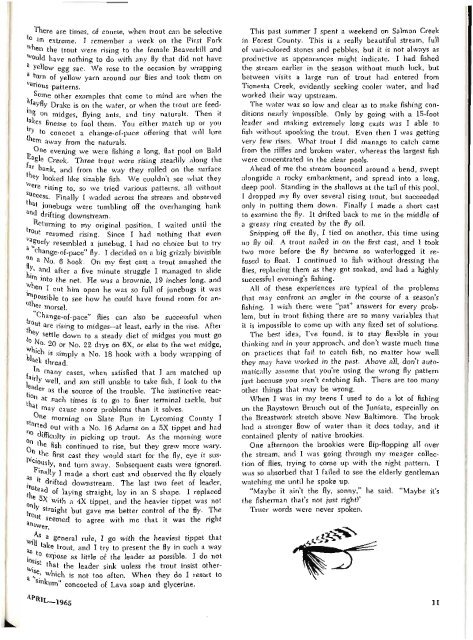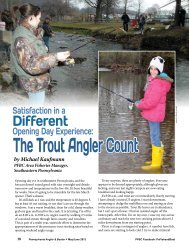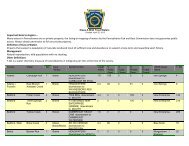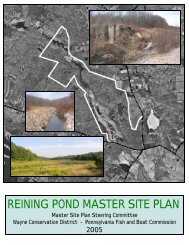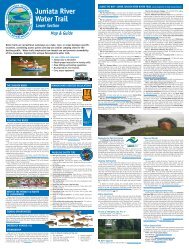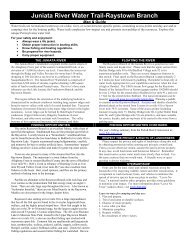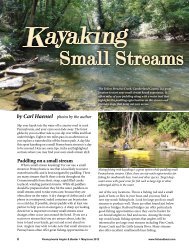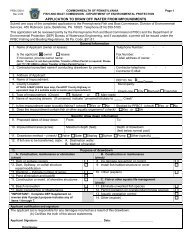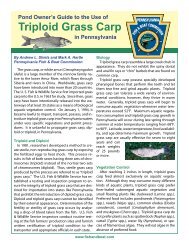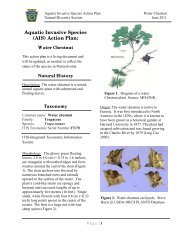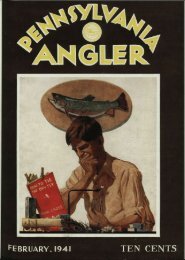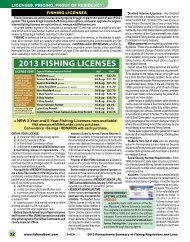m&M: - Pennsylvania Fish and Boat Commission
m&M: - Pennsylvania Fish and Boat Commission
m&M: - Pennsylvania Fish and Boat Commission
You also want an ePaper? Increase the reach of your titles
YUMPU automatically turns print PDFs into web optimized ePapers that Google loves.
There are times, of course, when trout can be selective<br />
0<br />
an extreme. I remember a week on the First Fork<br />
«6H the trout were rising to the female Beaverkill <strong>and</strong><br />
Quid have nothing to do with any fly that did not have<br />
yellow egg sac. We rose to the occasion by wrapping<br />
turn of yellow yarn around our flies <strong>and</strong> took them on<br />
Va<br />
rious patterns.<br />
kome other examples that come to mind are when the<br />
ayfly Drake is on the water, or when the trout are feed-<br />
§ on midges, flying ants, <strong>and</strong> tiny naturals. Then it<br />
a e<br />
* s finesse to fool them. You either match up or you<br />
j^ to concoct a change-of-pace offering that will lure<br />
eiJ<br />
i away from the naturals.<br />
One evening we were fishing a long, flat pool on Bald<br />
f- a gle Creek. Three trout were rising steadily along the<br />
, r bank, <strong>and</strong> from the way they rolled on the surface<br />
e<br />
y looked like sizable fish. We couldn't see what they<br />
ere<br />
rising to, so we tried various patterns, all without<br />
c<br />
cess. Finally I waded across the stream <strong>and</strong> observed<br />
at<br />
junebugs were tumbling off the overhanging bank<br />
n<br />
o drifting downstream.<br />
Returning to my original position, I waited until the<br />
trout<br />
resumed rising. Since I had nothing that even<br />
guely resembled a junebug, I had no choice but to try<br />
c<br />
nange-of-pace" fly. 1 decided on a big grizzly bivisible<br />
a No. 6 hook. On my first cast a trout smashed the<br />
y> <strong>and</strong> after a five minute struggle I managed to slide<br />
J« into the net. He was a brownie, 19 inches long, <strong>and</strong><br />
en I CU(. JJJJJJ 0pen ne was so fuu 0f junebugs it was<br />
Possible to see how he could have found room for an-<br />
0t<br />
her morsel.<br />
^hange-of-pace" flies can also be successful when<br />
1* are rising to midges—at least, early in the rise. After<br />
y settle down to a steady diet of midges you must go<br />
No. 20 or No. 22 drys on 6X, or else to the wet midge,<br />
ich is simply a No. 18 hook with a body wrapping of<br />
b,at<br />
* thread.<br />
n<br />
many cases, when satisfied that I am matched up<br />
* lr y well, <strong>and</strong> am still unable to take fish, I look to the<br />
oer as the source of the trouble. The instinctive reac-<br />
., a t such times is to go to finer terminal tackle, but<br />
may cause more problems than it solves.<br />
n<br />
e morning on Slate Run in Lycoming County I<br />
^ ar ted out with a No. 16 Adams on a 5X tippet <strong>and</strong> had<br />
O-ifficulty in picking up trout. As the morning wore<br />
Q ne fish continued to rise, but they grew more wary.<br />
the first cast they would start for the fly, eye it sus-<br />
°usly; <strong>and</strong> turn away. Subsequent casts were ignored.<br />
,'nally I made a short cast <strong>and</strong> observed the fly closely<br />
in t ^fted downstream. The last two feet of leader,<br />
e<br />
ad of laying straight, lay in an S shape. I replaced<br />
onl Wit ^ a as<br />
^ tippet, <strong>and</strong> the heavier tippet was not<br />
tr y straight but gave me better control of the fly. The<br />
t seemed to agree with me that it was the right<br />
v,,<br />
a general rule, I go with the heaviest tippet that<br />
take trout, <strong>and</strong> I try to present the fly in such a way<br />
, ° expose as little of the leader as possible. I do not<br />
/"! that the leader sink unless the trout insist othera<br />
« .' w hich is not too often. When they do I resort to<br />
ikum" concocted of Lava soap <strong>and</strong> glycerine.<br />
APR 1L-1965<br />
This past summer I spent a weekend on Salmon Creek<br />
in Forest County. This is a really beautiful stream, full<br />
of vari-colored stones <strong>and</strong> pebbles, but it is not always as<br />
productive as appearances might indicate. I had fished<br />
the stream earlier in the season without much luck, but<br />
between visits a large run of trout had entered from<br />
Tionesta Creek, evidently seeking cooler water, <strong>and</strong> had<br />
worked their way upstream.<br />
The water was so low <strong>and</strong> clear as to make fishing conditions<br />
nearly impossible. Only by going with a 15-foot<br />
leader <strong>and</strong> making extremely long casts was I able to<br />
fish without spooking the trout. Even then I was getting<br />
very few rises. What trout I did manage to catch came<br />
from the riffles <strong>and</strong> broken water, whereas the largest fish<br />
were concentrated in the clear pools.<br />
Ahead of me the stream bounced around a bend, swept<br />
alongside a rocky embankment, <strong>and</strong> spread into a long,<br />
deep pool. St<strong>and</strong>ing in the shallows at the tail of this pool,<br />
I dropped my fly over several rising trout, but succeeded<br />
only in putting them down. Finally I made a short cast<br />
to examine the fly. It drifted back to me in the middle of<br />
a greasy ring created by the fly oil.<br />
Snipping off the fly, I tied on another, this time using<br />
no fly oil. A trout nailed in on the first cast, <strong>and</strong> I took<br />
two more before the fly became so waterlogged it refused<br />
to float. I continued to fish without dressing the<br />
flies, replacing them as they got soaked, <strong>and</strong> had a highly<br />
successful evening's fishing.<br />
All of these experiences are typical of the problems<br />
that may confront an angler in the course of a season's<br />
fishing. I wish there were "pat" answers for every problem,<br />
but in trout fishing there are so many variables that<br />
it is impossible to come up with any fixed set of solutions.<br />
The best idea, I've found, is to stay flexible in your<br />
thinking <strong>and</strong> in your approach, <strong>and</strong> don't waste much time<br />
on practices that fail to catch fish, no matter how well<br />
they may have worked in the past. Above all, don't automatically<br />
assume that you're using the wrong fly pattern<br />
just because you aren't catching fish. There are too many<br />
other things that may be wrong.<br />
When I was in my teens I used to do a lot of fishing<br />
on the Raystown Branch out of the Juniata, especially on<br />
the Breastwork stretch above New Baltimore. The brook<br />
had a stronger flow of water than it does today, <strong>and</strong> it<br />
contained plenty of native brookies.<br />
One afternoon the brookies were flip-flopping all over<br />
the stream, <strong>and</strong> I was going through my meager collection<br />
of flies, trying to come up with the right pattern. I<br />
was so absorbed that I failed to see the elderly gentleman<br />
watching me until he spoke up.<br />
"Maybe it ain't the fly, sonny," he said. "Maybe it's<br />
the fisherman that's not just right!'<br />
Truer words were never spoken.<br />
^J*S*"<br />
11


